Ormesby
| Ormesby | |
| Yorkshire North Riding | |
|---|---|
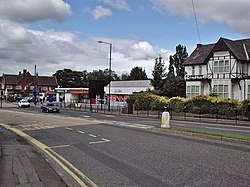 Ormesby High Street | |
| Location | |
| Grid reference: | NZ534166 |
| Location: | 54°32’57"N, 1°10’54"W |
| Data | |
| Population: | 10,714 (2011) |
| Post town: | Middlesbrough |
| Postcode: | TS7 and TS3 |
| Dialling code: | 01642 |
| Local Government | |
| Council: | Redcar and Cleveland / Middlesbrough |
| Parliamentary constituency: |
Redcar / Middlesbrough |
Ormesby a village in the North Riding of Yorkshire, in the very north of the Riding by the River Tees, to the east of Middlesbrough.
Parish church

St Cuthbert's Parish Church was largely rebuilt in th 19th century, between 1875 and 1907, to designs in the Decorated style] by architects W. S. & W.L. Hicks. The new building incorporated the Anglo Saxon foundations, carved work and re-dressed masonry from the 12th-century church.

In 1883 the attractive, oaken lych-gate was added to the Church Lane entrance to the churchyard. Elizabeth Brown paid for the erection of the church's tower, spire and her own cast-iron railed (grade II listed) churchyard monument, which is now a Grade II listed structure.
History
Ormesby manor and church are recorded in the Domesday Book of 1086 as the property of 'Orme': the name 'Ormesby is from the Norse for 'Orme's village'.
The manor of Ormesby was extensive and stretched about four miles from the banks of the River Tees to the brow of the hill south of Ormesby village. Its east and west boundaries were defined by two becks; Spencer Beck and Ormesby Beck. A Middle Beck ran parallel to the others, through the middle of the village and along Church Lane, dividing the manor into two strips of land of roughly the same size.
The village itself was likely centred on Church Lane, being part of the ancient road that linked the River Tees to Guisborough and Stokesley.
In the Middle Ages, a substantial part of the manor was granted to Gisborough Priory. At this time, a grange, also known as a 'priory farm', was established in the general location of the existing Grange Farm and Ormesby Hall. It is possible, therefore, that the grange farmhouse may have occupied the site of the 17th-century house built by the Pennymans and now incorporated into the present Ormesby Hall.
The records from Gisborough Priory suggest that the grange was accompanied by a settlement consisting of two rows of properties facing each other across Church Lane.
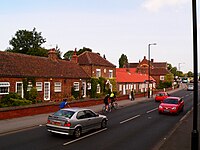
A surviving remnant of the original Ormesby village is the High Street's 18th-century Sundial Row, a terrace of ex-almshouses and stables which are now private houses. Alongside the almshouses is a betting shop which was once a school, it bears the inscription:
THIS PUBLICK SCHOOL HOUSE WAS ERECTED IN THE YEAR 1744 AND REBUILT IN 1773.
These buildings, together with Ormesby Hall, a Grade I listed National Trust property, form the centrepieces to a conservation area.
1900s
Miss Elizabeth Caroline Brown, who died in 1905, was a noted local benefactor and paid for the erection of a number of buildings in Ormesby including Ormesby House and the now demolished Ormesby School.
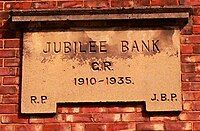
Ormesby Hall estate built a row of three brick and tile cottages, where numbers 2–6 Church Lane are now located, at the beginning of the 20th century. Some thirty years later, to mark the Silver Jubilee of King King George V in 1935, Colonel Pennyman pulled down the old Black Lion Inn and the cottages on Church Lane to erected Jubilee Bank.
Jubilee Bank was created as a row of twenty-eight estate workers' cottages to replace the four previous buildings. Architects, Kitching & Co of Middlesbrough, designed both rows in the fashionable Arts and Crafts vernacular style. A row of four cottages, opposite Ormesby House, were demolished in the 1960s. Mudd's Cottage, currently numbered 38, and the old Vicarage (now known as Hambleton House) still survive.
About the village
Diamond Jubilee Memorial
Queen Victoria's Diamond Jubilee Memorial, a stone column, with a lamp at the top, was built in Ormesby by Elizabeth Caroline Brown of Ormesby House, in 1897. The lamp was damaged when being moved, and has since been replaced with a cross.
, to commemorate HRH Queen Victoria's Diamond Jubilee, in 1897. ||The memorial was originally sited at the junction of Church Lane and Ormesby High Street.| The 1897 memorial on Church Lane | ||
| Back | Queen Victoria Memorial | Front |
|---|---|---|
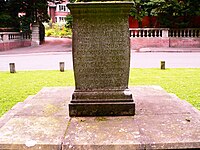 |
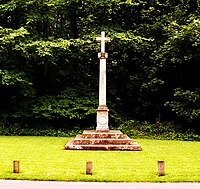 |
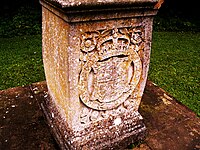
|
Ormesby Hall
- Main article: Ormesby Hall

The manor of Ormesby was acquired by the Pennyman family when they bought up lands formerly owned by Gisborough Priory. In about 1600, they set about building what would have been little more than a large farmhouse, and continued to buy lands around the village. The Pennymans were forced to sell the eastern half of their estate in 1715, only to buy it again in 1771, and sell it again, to John Brown of Liverpool. This division of the estate inevitably influenced the way in which Ormesby developed over the next 200 years.[1] With some of the Ormesby manor changing hands, more than once, a second house was built by the new owners, in the 1700s.
From the Victorian period the park was used by the Pennyman family, as well as the local community, for sports, with cricket and football in the summer (the cricket pitch remains) and golf in the winter months. Horticultural shows, garden fetes and political rallies followed. The Hall was, from 1664 until 1852, the seat of the Baronets Pennyman of Ormesby.
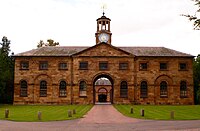
Today, Ormesby Hall, is in the care of the National Trust and is opened to the public. The stable block housed the horses of the Cleveland Police Mounted Section, until it was disbanded in 2013.
Ormesby House
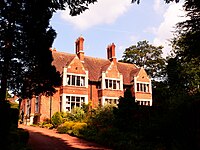
Rebuilding on the former 18th century Ormesby Manor House's site, a new Ormesby Manor House was built in 1904 by its owner, Miss Elizabeth Caroline Brown. The architect, Fred Rowntree, designed the detached house in a Jacobethan style with red brick, concrete dressings and to be set back into its gardens. It is probable that the subterranean remains of the house survive under the early 20th century house.
Pictures
| ("Wikimedia Commons" has material about Ormesby) |
-
Eston Nab looms beyond Ormesby
-
The Fountain Pub
-
Spencerbeck House; Ormesby's only high rise block
-
Ormesby Bank
-
Priestfields shops
References
- ↑ Atkinson, Rev. J. C. "History of Cleveland Ancient and Modern," J. Richardson, London, Vol. I (appendage), 1874, pp. 1/6.





